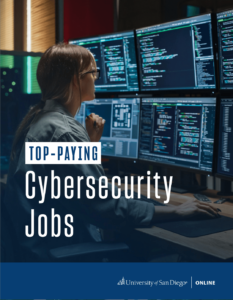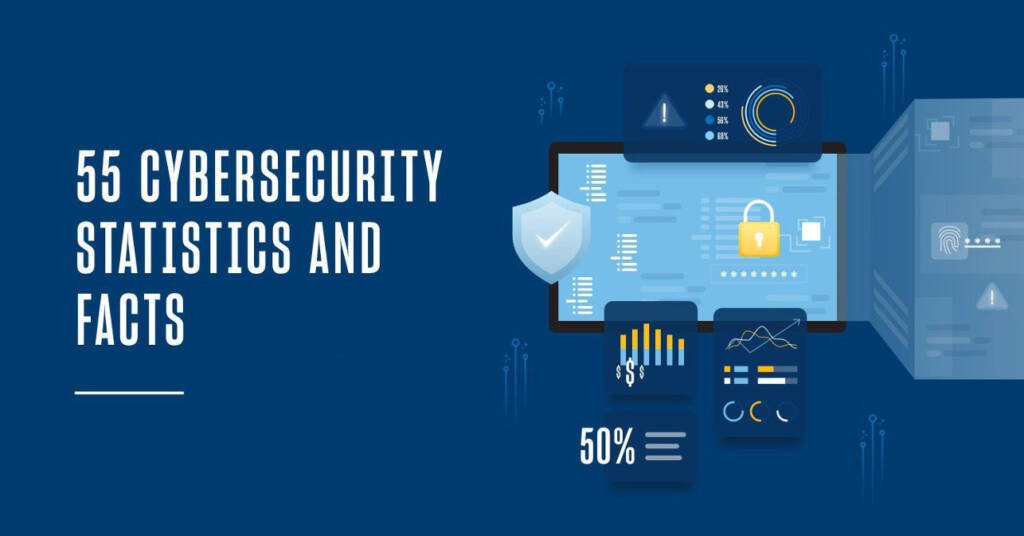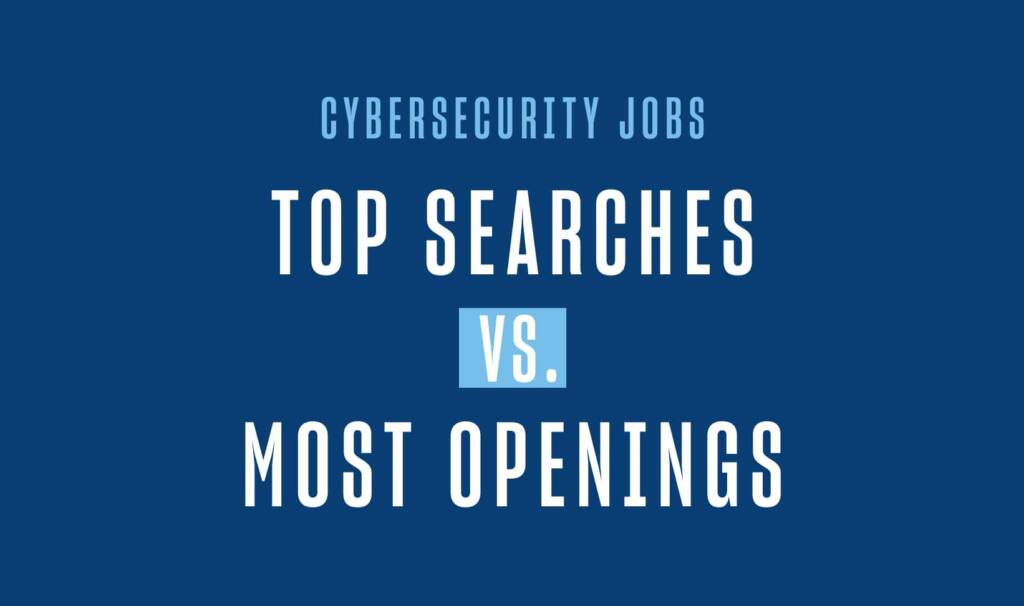A host of new and evolving cybersecurity threats has the information security industry on high alert. Ever-more sophisticated cyberattacks involving malware, phishing, machine learning and artificial intelligence, cryptocurrency and more have placed the data and assets of corporations, governments and individuals at constant risk. Grasping the top cybersecurity threats is essential for crafting strong defenses and fostering a secure digital environment.
According to estimates from Statista’s Market Insights, the global cost of cybercrime is anticipated to surge dramatically, escalating from $9.22 trillion in 2024 to a staggering $13.82 trillion by 2028. This alarming trend underscores the urgent need for heightened vigilance and innovation in cybersecurity strategies.
[RELATED] 10 Reasons to Join a Cyber Security Master’s Degree Program >>
The nonprofit Information Security Forum, a self-proclaimed leading authority on cyber, information security and risk management, warns in its annual Threat Horizon study of:
- Disruption — Over-reliance on fragile connectivity creates the potential for premeditated internet outages capable of bringing trade to its knees and heightened risk that ransomware will be used to hijack the Internet of Things.
- Distortion — The intentional spread of misinformation, including by bots and automated sources, causes trust in the integrity of information to be compromised.
- Deterioration — Rapid advances in intelligent technologies plus conflicting demands posed by evolving national security and individual privacy regulations negatively impact organizations’ ability to control their own information.
According to Statista, the global cost of cybercrime is projected to rise from $9.22 trillion in 2024 to $13.82 trillion by 2028. This massive increase shows how serious the financial impact of cybercrime has become, exceeding the yearly damage caused by natural disasters and competing with the profits of the illegal drug trade. The escalating threat endangers innovation, business investment, and economic stability, stressing the critical need for improved cybersecurity.
[RELATED] How to Land the 9 Best Jobs in Cybersecurity >>
Types of Cyber Threats
As digital landscapes evolve, so do the types of cyber threats that target them. These threats can be broadly categorized into several types, each with unique characteristics and methodologies:
- Malware continues to be prevalent, encompassing various forms such as viruses, ransomware and spyware. These malicious programs can disrupt operations, steal information or damage systems.
- Social engineering exploits human interactions to gain unauthorized access to valuable information and systems. Phishing, one of the most common forms, tricks users into divulging sensitive data.
- Insider threats arise from within an organization and can be accidental or malicious. These threats are particularly insidious as they bypass traditional security measures with legitimate access.
- Advanced persistent threats (APTs) are complex, stealthy and prolonged attacks aimed at specific targets to steal data or disrupt operations, often undetected for long periods.
- Distributed denial of service (DDoS) attacks overload systems with floods of internet traffic. These attacks disrupt services and can serve as a smokescreen for more invasive attacks.
- Ransomware attacks involve encrypting the victim’s data and demanding payment for decryption keys. These attacks can paralyze critical systems and demand significant financial payouts.
- Man-in-the-middle (MitM) attacks intercept communications between two parties to steal or manipulate information.
- Supply chain attacks compromise software or hardware before they reach the consumer, exploiting trusted relationships.
Top Cybersecurity Threats in 2025
In the following sections, we’ll explore the complexities and defense strategies against these top cybersecurity threats shaping the landscape in 2025.
AI-powered Cyber-Attacks
AI-powered cyber-attacks are emerging as a significant challenge in the cybersecurity arena. Cybercriminals are using artificial intelligence to elevate the sophistication and impact of their attacks, making them increasingly elusive and harder to detect. These AI-driven threats can automate vulnerability identification, craft convincing phishing schemes and even adapt in real-time to circumvent security measures.
The dynamic nature of AI means traditional defenses may no longer be sufficient. This calls for a proactive and innovative approach to cybersecurity. Organizations must prioritize investment in AI-driven security solutions and continuously refine their strategies to stay ahead of these rapidly evolving threats.
Deepfake Technology
Deepfake technology uses artificial intelligence to create realistic fake videos, images, or audio that mimic real people, often making it difficult to tell them apart from genuine content. It is quickly becoming a powerful tool for cybercriminals, with the number of deepfakes online surging dramatically, increasing by 550% from 2019 to 2023. According to DeepMedia, around 500,000 video and voice deepfakes were shared on social media worldwide in 2023 alone. By 2025, this figure is expected to surge to 8 million, reflecting the exponential growth of this technology.
One good example of this threat is a recent fake photo of a superstar endorsing a politician, after which the superstar clarified and endorsed a different candidate. The widespread availability of advanced AI tools and the abundance of publicly accessible data fuel the proliferation of deepfakes, making them a significant challenge for cybersecurity efforts.
Malware Threats
Malware, or malicious software, continues to be a formidable threat to cybersecurity landscapes worldwide. In 2025, AI-enhanced malware attacks have emerged as a primary concern for U.S. IT professionals, with 60% of IT experts globally identifying it as the most concerning AI-generated threat for the next 12 months. Below are some of the primary types of malware posing significant threats this year:
Viruses and Worms
Viruses and worms are some of the oldest types of malware but remain highly effective due to their evolving mechanisms. Viruses attach themselves to clean files and infect other clean files, which can spread uncontrollably, damaging the system’s core functionality and corrupting data. Worms, on the other hand, self-replicate without human intervention and typically exploit vulnerabilities within the system’s network. Recent variations have seen worms that can evade detection by mimicking benign network traffic.
Ransomware
According to MoreField’s Cybersecurity 2025 forecast, ransomware attacks are at the forefront of emerging threats, with their frequency and sophistication on the rise. Demonstrating an alarming 81% year-over-year increase from 2023 to 2024, these attacks are becoming increasingly prevalent, underscoring the urgent need for enhanced security measures.
Cryptojacking
Cryptojacking is a stealthy threat that remains under the radar but poses significant risks as it hijacks computer resources to mine cryptocurrency. Unlike other forms of malware, cryptojacking focuses on generating revenue without direct theft or data compromise, making it less noticeable but equally damaging in terms of resource utilization.
Fileless Malware
Fileless malware leverages scripts or loaded modules into the random access memory (RAM) without writing to the disk, making it difficult for traditional antivirus solutions to detect. This type of attack exploits existing, legitimate programs to execute malicious activities, often bypassing user and endpoint defenses.
To combat these malware threats, organizations should adopt a layered security approach that includes regular software updates, comprehensive end-user education to guard against phishing, advanced threat detection systems and rigorous access controls. Employing a robust cybersecurity framework and conducting regular audits will help with the early detection and mitigation of these cybersecurity threats.
Social Engineering Attacks
Social engineering remains one of the most insidious types of cyber threats because it exploits human psychology rather than technological vulnerabilities. These attacks trick individuals into breaking normal security procedures, often leading to significant data breaches or financial losses. Here’s how these schemes are evolving in 2025:
Phishing Variants
- Spear phishing: Spear phishing targets individuals with highly tailored and convincing messages, often appearing to be from colleagues or trusted sources. For example, attackers might pose as remote tech support agents to address VPN complications, leveraging common workplace issues to manipulate employees during widespread remote work periods.
- Vishing (voice phishing): In vishing scenarios, attackers use phone calls to extract sensitive information under the guise of legitimate requests. A typical scheme involves impersonators claiming to represent a bank, alerting victims about suspicious transactions and coaxing them into verifying personal account details, which can lead to financial theft.
- Smishing (SMS phishing): This technique involves text messages sent under the guise of urgency requiring immediate action such as clicking a link to track an undelivered package. The link, however, redirects the recipient to a malicious site intended to compromise personal data.
Baiting and Pretexting
- Baiting: Baiting tactics involve enticing victims with the promise of goods or information. One common method includes distributing USB drives, purportedly containing important work-related data like employee salary lists, which actually contain harmful malware designed to infiltrate corporate networks.
- Pretexting: Attackers often use pretexting to obtain personal information under false pretenses. They might, for instance, pose as surveyors needing confidential data for supposed business or security audits, exploiting the targeted individuals’ trust and cooperative instincts.
Business Email Compromise
In 2025, Business email compromise (BEC) remains a prevalent and sophisticated threat, using email fraud to trick companies into transferring money or sensitive data to cybercriminals. These schemes have evolved, with fraudsters conducting extensive research to convincingly mimic internal communications. For example, attackers have used compromised emails to request wire transfers under the guise of urgent and confidential business deals. These emails are often only identified as fraud after the transaction is completed, leading to substantial financial losses for businesses.
To defend against social engineering attacks, organizations must prioritize security awareness training for employees to recognize and respond appropriately to such schemes. Implementing multi-factor authentication (MFA) can also significantly reduce the risk of successful breaches originating from social engineering tactics.
Network and Application Attacks
As cyber threats evolve, network and application attacks have become more sophisticated, targeting the very backbone of organizational IT infrastructures. Here’s how these attacks are currently manifesting:
Distributed Denial of Service Attacks
In 2025, DDoS attacks will remain a formidable threat, overwhelming networks, servers or websites with excessive traffic to deplete resources and bandwidth, making the services unavailable to legitimate users. The first half of 2024 saw a 25% rise in multi-vector attacks, with carpet bomb attacks spreading traffic across multiple IPs, challenging security teams in real time.
Amplification attacks have exacerbated this issue, leveraging publicly accessible DNS (Domain Name System, which translates domain names to IP addresses), NTP (Network Time Protocol, which synchronizes clocks over a computer network) and SNMP (Simple Network Management Protocol, used for collecting information and managing network devices) servers to significantly intensify the assault, often crippling systems within minutes.
Man-in-the-Middle Attacks
MitM attacks occur when attackers intercept and alter communications between two parties without their knowledge. These attacks have grown more complex with the increase in encrypted traffic via HTTPS. Attackers often exploit flaws in SSL/TLS protocols or use stolen certificates to decrypt and manipulate communications.
In 2024, IBM reported that security researchers uncovered a vulnerability that allows hackers to execute a MitM attack to unlock and steal Tesla vehicles. By setting up a spoofed WiFi hotspot at a Tesla charging station, attackers can capture the account credentials of Tesla owners. With these credentials, they can add a new “phone key,” enabling them to unlock and start the vehicle without the owner’s knowledge.
Injection Attacks
Injection attacks are prevalent across various platforms, particularly web applications. They occur when an attacker sends untrusted data to an interpreter as part of a command or query. The interpreter then executes unintended commands or accesses data without proper authorization.
- SQL injection: SQL is a powerful tool for managing and manipulating structured data. By inserting malicious SQL statements — commands used to communicate with a database to perform tasks, queries and operations on data — into input fields, attackers can manipulate a database to disclose information, modify data or even delete it. Recent breaches have shown attackers exploiting even minutely flawed SQL queries to extract massive volumes of data.
- Code injection: These attacks involve the injection of malicious code into a vulnerable application, which is then executed by the server. Common targets include applications that dynamically evaluate code stored in user-controllable locations.
- OS command injection: This type of injection attack occurs when an attacker gains the ability to execute shell commands — instructions or commands that you input into a command-line interface or terminal to perform operations on a computer system — on a server. By manipulating input forms that are processed by application servers, attackers can execute arbitrary commands, often taking full control of the underlying operating system.
Defending against network and application attacks requires a multi-faceted approach:
- For DDoS: Employ comprehensive threat monitoring systems to detect and mitigate attacks before they can cause significant damage. Utilizing rate limiting (which controls the amount and rate of traffic sent or received by a network server), web application firewalls (WAFs) and anti-DDoS hardware and software solutions are critical.
- For MitM: Ensure proper SSL/TLS configurations — cryptographic protocols designed to provide secure communication over a computer network — and keep all certificates up-to-date. Educating users on the security of their internet connections, especially on public networks, is also vital.
- For injection attacks: Implement rigorous input validation, use prepared statements with parameterized queries in databases and regularly review and update codebases to safeguard against vulnerabilities.
Digital Infrastructure Threats
As technology advances, new types of cybersecurity challenges emerge, particularly in the rapidly expanding domains of the Internet of Things (IoT), supply chains and cloud computing. These sectors are increasingly integral to organizational operations and are consequently becoming prime targets for cyberattacks.
Internet of Things Attacks
The Internet of Things encompasses a vast array of devices — from household appliances to industrial equipment — all connected online. These devices often lack robust security features, making them susceptible to attacks. Common vulnerabilities include insecure firmware, weak authentication protocols and unsecured network services. Statista projects IoT devices will nearly double from 15.9 billion in 2023 to over USD 32.1 billion by 2030.
For example, IoT devices can be compromised to create botnets that launch massive DDoS attacks. As the IoT continues to grow, securing these devices becomes increasingly critical, necessitating the development of new security frameworks and the adoption of rigorous security practices at the development stage.
Supply Chain Attacks
Supply chain attacks exploit the interconnected systems of organizations, targeting trusted relationships to breach multiple entities through a single attack. These types of attacks have grown quickly, affecting 2,600% more organizations since 2018. In 2023 alone, the number of victims increased by 15%, affecting more than 54 million individuals. Such disruptions led to an average of $82 million in annual losses per organization in key industries like aerospace, defense, health care, and energy.
Cloud Security
As businesses increasingly rely on cloud computing, vulnerabilities in cloud infrastructure have become more apparent. Misconfigurations and inadequate access controls are the most common issues that lead to unauthorized access and data breaches. For instance, improperly configured S3 buckets — a fundamental storage resource in Amazon Web Services (AWS) — have led to significant data losses for even major corporations.
Preventive measures include:
- IoT security: Regular firmware updates, default credential changes and network segmentation can significantly enhance the security of IoT devices.
- Supply chain security: Continuous vetting, adherence to strict security standards by all parties and integrating security practices into contract agreements are vital.
- Cloud security: Utilization of automated tools to monitor and correct configurations, rigorous access controls and employee training on cloud security best practices are critical for safeguarding cloud environments.
State-sponsored and Insider Threats
As the cyber landscape becomes increasingly politicized and competitive, state-sponsored cyber activities and insider threats have risen sharply, posing sophisticated and stealthy challenges to global security infrastructures.
Nation-state Cyber Activities
Nation-state cyber activities often involve operations aimed at espionage, sabotage or influencing global political landscapes. Recent examples include Russian government-sponsored groups targeting critical infrastructure in the United States and Ukraine, primarily through malware and DDoS attacks, to disrupt services and gather intelligence.
Another example is Chinese cyber units conducting prolonged espionage against technology companies to steal intellectual property and sensitive government data. These operations are characterized by their high level of sophistication, significant state resources and long-term objectives that often align with national military or economic strategies.
Insider Threats
Insider threats arise from individuals within an organization who misuse their access to systems and data, either maliciously or through negligence. Strategies to detect and prevent these threats include:
- Behavioral analytics: Implementing user and entity behavior analytics (UEBA) to detect anomalous behavior patterns that may indicate malicious activity or policy violations
- Access controls: Applying the principle of least privilege and regularly reviewing access permissions to ensure that employees only have access to the resources necessary for their job functions
- Regular audits and training: Conducting comprehensive security audits and providing ongoing security awareness training to educate employees about the indicators of insider threats and the importance of following organizational security policies
Mitigation strategies include the following:
- For nation-state threats: Strengthening national cybersecurity policies, enhancing international cooperation and developing counter-cyber espionage strategies are critical. Organizations should also invest in cybersecurity intelligence to stay ahead of new threats posed by foreign governments.
- For insider threats: Establishing a clear policy that outlines acceptable and secure behaviors, integrating robust data loss prevention (DLP) technologies and maintaining an up-to-date incident response plan that includes provisions for insider incidents.
Privacy Concerns and Data Breaches
In an era when data is a critical asset, privacy concerns and data breaches have become central issues for organizations worldwide. Regulatory changes and compliance with international laws significantly shape cybersecurity strategies, while lessons from major breaches provide crucial insights for security enhancements.
Regulatory Changes and Compliance
The impact of international laws, such as the General Data Protection Regulation (GDPR) and the California Consumer Privacy Act (CCPA), has redefined cybersecurity strategies. These regulations impose stringent data protection requirements on organizations, mandating robust measures to safeguard consumer information and severe penalties for non-compliance.
For instance, GDPR’s provisions for data breach notifications have forced companies to enhance their incident response strategies to detect and mitigate breaches more rapidly. Compliance not only ensures legal conformity but also helps in building trust with consumers by protecting their personal information.
Major Data Breaches
Several high-profile data breaches in recent years have exposed the vulnerabilities in cybersecurity defenses and underscored the need for stringent security measures. For example:
- The Equifax breach was one of the most significant data breaches, compromising the personal information of approximately 147 million consumers. This incident highlighted the importance of patch management, as the breach was due to an unpatched vulnerability in a web application.
- The Capital One breach exposed the data of over 100 million customers after a misconfigured web application firewall was exploited. This breach emphasized the need for comprehensive security configurations and routine security assessments.
Companies and organizations can address these risks by incorporating the following preventive measures:
- Continuous monitoring and updates: Regularly update and monitor systems to defend against new vulnerabilities.
- Enhanced incident response: Develop and rehearse incident response protocols to handle data breaches effectively, ensuring rapid mitigation and compliance with breach notification laws.
- Education and awareness: Conduct ongoing training for employees on cybersecurity best practices and phishing recognition to reduce the risk of human error.
- Compliance audits: Perform regular audits to ensure all systems comply with relevant international and local privacy laws.
- Advanced security infrastructure: Invest in advanced security technologies, including encryption, intrusion detection systems and comprehensive endpoint security, to mitigate data breach risks.
- Third-party risk management: Incorporate rigorous security assessments and controls into all third-party contracts to prevent breaches through vendors.
Advanced Persistent Threats (APTs)
APTs are complex cyberattacks aimed primarily at stealing information or sabotaging operations, often targeting national governments, infrastructure and large corporations. These threats are executed over extended periods, making them discreet and particularly dangerous due to the strategic planning that underpins them.
Characteristics of APTs
APTs distinguish themselves through their sophistication and persistence, with attackers focusing on achieving their long-term objective by avoiding detection. Here are some defining characteristics of APTs:
- Highly targeted: Attackers spend considerable time and resources to target specific entities or sectors. They tailor their tactics, techniques and procedures (TTPs) based on the vulnerabilities and value of their targets.
- Long-term engagement: Unlike other cyber threats that seek quick hits, APTs involve long durations of engagement with the target’s network, sometimes lasting years to continuously steal data or await the right moment to strike.
- Use of advanced malware: These threats often involve complex malware and spear-phishing attacks to gain initial access and maintain persistence within the target’s infrastructure.
- Evasion techniques: APTs use sophisticated methods to evade detection, including encryption, kill switches and exploiting zero-day vulnerabilities.
- Lateral movement: Once access is gained, APTs move laterally through the network to establish footholds in different parts of the organization’s digital infrastructure.
Defending against APTs requires a multi-layered approach, combining advanced security technologies with vigilant monitoring and rapid response strategies. Here are some effective prevention and defense measures:
- Regular security assessments: Continuously assess and update the security posture of the organization to respond to emerging threats.
- Encryption: Encrypt sensitive data both at rest and in transit to reduce the usefulness of intercepted information by unauthorized parties.
- Threat intelligence sharing: Participating in industry and government cybersecurity initiatives can provide early warnings about new APT tactics and remediation techniques.
- Segmentation and zero trust: Implement network segmentation and adopt a zero-trust security model to minimize lateral movements and restrict access to critical information.
- Advanced detection technologies: Utilize behavior-based threat detection systems that can identify anomalies indicative of APT activities, such as unusual network traffic or unexpected data flows.
- Incident response and forensics: Prepare a comprehensive incident response plan that includes forensic capabilities to investigate and mitigate breaches after an APT attack is detected.
- Continuous monitoring and updating: Regularly update security systems and software to protect against known vulnerabilities and perform continuous monitoring of all network activity to detect and respond to threats promptly.
- Employee training and awareness: Educate employees about the risks and indicators of APTs, particularly focusing on spear-phishing and social engineering tactics, as human elements are often the weakest links in security chains.
A Severe Shortage of Cybersecurity Professionals
The cybersecurity workforce shortage has reached a critical level, exacerbated by challenging economic conditions that have led to increased resource reductions. According to the 2024 ISC2 Cybersecurity Workforce Study, 25% of respondents reported layoffs in their cybersecurity departments, marking a 3% increase from 2023 while 37% experienced budget cuts, up 7% from the previous year.
Despite these challenges, CyberSeek, a government-backed project tracking the industry, reported over 457,000 cyber-related job postings between September 2023 and August 2024. Although cybersecurity job postings were down 22% during this period, the security market fared better than the overall tech market, which saw a 28% decline in job postings. This underscores the escalating need for qualified cybersecurity professionals as the workforce gap continues to widen.
What Companies Are Doing to Combat Threats in Cybersecurity
One of the most effective methods for preventing and mitigating threats in cybersecurity and attacks is through proper cybersecurity education. Many companies and organizations are using webinars and training tools to keep employees informed of best practices and updated protocols.
Companies may also adopt new technologies and run security audits, in addition to hiring experienced cybersecurity professionals and/or consultants to help strengthen their cyber defenses.
To address the most critical challenges in cybersecurity, the University of San Diego offers two specialized master’s programs: the innovative online Master of Science in Cyber Security Operations and Leadership and Master of Science in Cyber Security Engineering, available both on campus and online.





